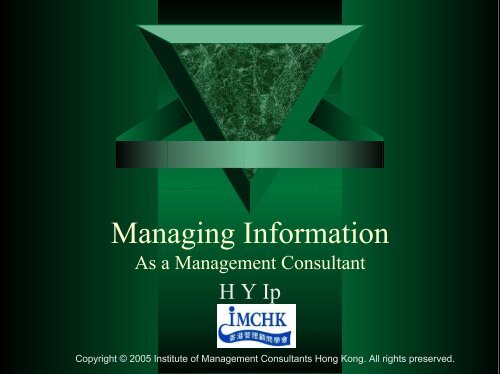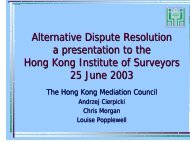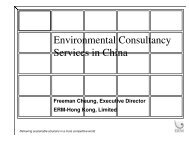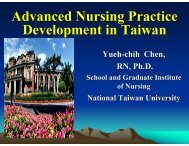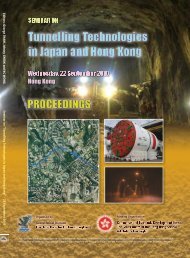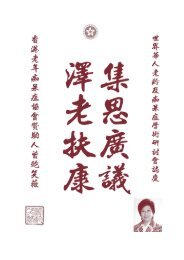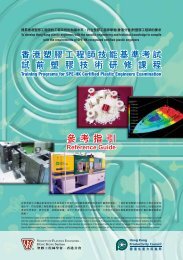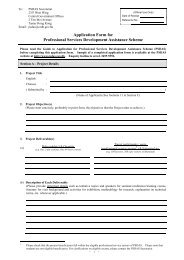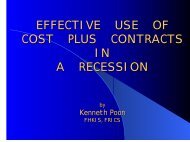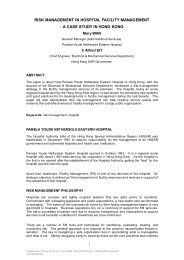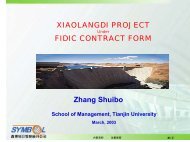Managing Information
Managing Information
Managing Information
You also want an ePaper? Increase the reach of your titles
YUMPU automatically turns print PDFs into web optimized ePapers that Google loves.
<strong>Managing</strong> <strong>Information</strong><br />
As a Management Consultant<br />
H Y Ip<br />
Copyright © 2005 Institute of Management Consultants Hong Kong. All rights preserved.
Course Objectives<br />
To learn the concepts and skills of<br />
managing information in a management<br />
consultant firm.<br />
To apply the concepts and skills of<br />
managing information as a management<br />
consultant for a successful assignment.<br />
Copyright © 2005 Institute of Management Consultants Hong Kong.<br />
All rights preserved.<br />
VA<br />
1
Course Content<br />
Data, <strong>Information</strong> and Knowledge<br />
Why <strong>Managing</strong> <strong>Information</strong><br />
Concepts of <strong>Managing</strong> <strong>Information</strong> (MI)<br />
<strong>Managing</strong> Data on Staff<br />
Knowledge management in management<br />
consulting- practices<br />
<strong>Managing</strong> an Assignment<br />
Client and Past Assignments<br />
Copyright © 2005 Institute of Management Consultants Hong Kong.<br />
All rights preserved.<br />
VA<br />
2
Data<br />
A fact, presented as an item out of context<br />
With no apparent relationship to anything<br />
Examples:<br />
– 101101<br />
– MAY<br />
–17<br />
Copyright © 2005 Institute of Management Consultants Hong Kong.<br />
All rights preserved.<br />
VA<br />
3
<strong>Information</strong><br />
Adds context through relationships between data,<br />
or other information.<br />
– Limited in context about the past or present, with little<br />
implication for the future<br />
– Example: 101101 becomes information if it is<br />
defined in the “date” context and the<br />
relationship within it is also defined such as<br />
dd/mm/yy limited to the current century.<br />
– “date” is well defined in the past up to now (it<br />
may be “known” as something else in the future)<br />
Copyright © 2005 Institute of Management Consultants Hong Kong.<br />
All rights preserved.<br />
VA<br />
4
Knowledge<br />
Adds understanding and retention to information<br />
– To have "knowledge" requires information to be<br />
processed between data, information, and other<br />
knowledge, knowing and remembering all steps in the<br />
process.<br />
– Example:Knowing and remembering how to convert<br />
any binary number to decimal number such as<br />
converting the binary number 101101 to decimal<br />
number 45<br />
Copyright © 2005 Institute of Management Consultants Hong Kong.<br />
All rights preserved.<br />
VA<br />
5
Knowledge Management<br />
A concept to collect, analyze, organize, and share<br />
the knowledge of individuals and groups across<br />
the organization in order to enhance performance<br />
– Example: a process to help people to communicate and<br />
share information leading to business success.<br />
A KM process is about getting the right data, in<br />
the right context, to the right person, at the right<br />
time, for the right business objective.<br />
Copyright © 2005 Institute of Management Consultants Hong Kong.<br />
All rights preserved.<br />
VA<br />
6
Skills and Knowledge<br />
Processing in STM, MTM, LTM<br />
– CPU, Cache, SIMM, Disk<br />
– Driving a car vs Binary-decimal conversion<br />
Vocational training vs professional practice<br />
Very Personal (no clear cut definition in general)<br />
Tacit to Explicit (lossy skill transfer)<br />
– Capturing explicit part of knowledge with process<br />
Explicit to Tacit (skill regeneration)<br />
– <strong>Information</strong> to Knowledge transformation<br />
Copyright © 2005 Institute of Management Consultants Hong Kong.<br />
All rights preserved.<br />
VA<br />
7
Knowledge types<br />
Tacit knowledge<br />
– Very personal<br />
o Cannot be separated from owner<br />
o Cannot be fully transferred or transformed<br />
– Situational (some “guess” involved)<br />
o Cannot be represented by simple algorithms<br />
o Often as unique, one-off decision making<br />
– Partially transferred by apprenticeship, mentoring and<br />
coaching<br />
Explicit knowledge<br />
– Transformed tacit knowledge (with losses) on media<br />
Copyright © 2005 Institute of Management Consultants Hong Kong.<br />
All rights preserved.<br />
VA<br />
8
Why <strong>Managing</strong> <strong>Information</strong>?<br />
As a bridge to KM (knowledge management)<br />
– Knowledge cannot be fully captured by non-human yet<br />
– KM can be managed but it requires specific strategy,<br />
technology and people depending on situations<br />
– MI Based on good MD (managing data) infrastructure<br />
and practices<br />
– Past and current can be captured<br />
– The best manageable and reusable (regenerate<br />
knowledge) format currently<br />
Copyright © 2005 Institute of Management Consultants Hong Kong.<br />
All rights preserved.<br />
VA<br />
9
Concepts of<br />
<strong>Managing</strong> <strong>Information</strong><br />
Relevancy – What is needed?<br />
– A typhoon signal hoisted in the nearby region should<br />
not be the reason in canceling the important event<br />
tomorrow. (However, a contingency plan should be in<br />
place)<br />
Accuracy – How is it needed?<br />
– The hoisting of No. 8 signal for less than an hour before<br />
taking it down is not accurate for making many<br />
decisions of impact. (It is a false alarm)<br />
Timeliness – When is it needed?<br />
– The hoisting of No. 8 signal should be just in time<br />
before the typhoon effects arrived for major decision.<br />
Copyright © 2005 Institute of Management Consultants Hong Kong.<br />
All rights preserved.<br />
VA<br />
10
Concepts of<br />
<strong>Managing</strong> <strong>Information</strong> (2)<br />
Completeness – What is enough to decide?<br />
– The signal hoisting should be followed by<br />
announcement from the HK Observatory and<br />
authorized government depts. The notice should be<br />
announced thru all possible media for the public to<br />
receive and enquire information.<br />
Simplicity – How easy is it to understand?<br />
– The well-defined and publicized icon of the twotriangles<br />
pattern would be displayed for easy cognition.<br />
Lengthy press release is not necessary for the initial<br />
announcement.<br />
Copyright © 2005 Institute of Management Consultants Hong Kong.<br />
All rights preserved.<br />
VA<br />
11
Relevancy<br />
<strong>Information</strong> is only relevant and needed, if it is<br />
used to make a decision<br />
When asking for information:<br />
– How can we apply this principle in practice?<br />
– ask for exact, no more, no less<br />
– tell decision basis<br />
When asked to provide information:<br />
– ask what decision is to be made, based on it<br />
– confirm that the information you will provide is exactly<br />
what is required.<br />
Copyright © 2005 Institute of Management Consultants Hong Kong.<br />
All rights preserved.<br />
VA<br />
12
Accuracy<br />
Accuracy may lead to wrong decision<br />
– Not enough <strong>Information</strong> may not be sufficient<br />
to make a decision<br />
– Too accurate may not include the crucial<br />
uncertainty<br />
Copyright © 2005 Institute of Management Consultants Hong Kong.<br />
All rights preserved.<br />
VA<br />
13
Timeliness<br />
<strong>Information</strong> is only required when and<br />
where decisions have to be made<br />
– Wrong people vs Right people<br />
• Executives vs Front line saleman<br />
– Wrong time vs just-in-time<br />
• Too early (incomplete info.)<br />
• Shipment arrived/on the shelf<br />
Copyright © 2005 Institute of Management Consultants Hong Kong.<br />
All rights preserved.<br />
VA<br />
14
A <strong>Managing</strong> <strong>Information</strong><br />
Process<br />
To deciding which information you need:<br />
– Determine what the objectives are,<br />
– Decide on what decisions to make,<br />
– Decide on what information (relevancy,<br />
completeness, simplicity) are needed,<br />
– Determine when to make the decisions,<br />
– Decide on the accuracy required to make the<br />
decisions.<br />
Copyright © 2005 Institute of Management Consultants Hong Kong.<br />
All rights preserved.<br />
VA<br />
15
Example of a MI Process<br />
OBJECTIVES<br />
Increase<br />
assignment<br />
revenue by 6%<br />
DECISION<br />
Advertise<br />
When and how?<br />
Launch new<br />
services<br />
INFORMATION<br />
Forecast HR activities figures<br />
Previous and planned advertising<br />
campaigns<br />
Competitors’ advertising<br />
campaigns<br />
Advertising rates<br />
Revenue growth figures during<br />
advertising campaigns<br />
Market research<br />
Market share by services –<br />
competitors and ours<br />
Planned new service experts in<br />
development<br />
Copyright © 2005 Institute of Management Consultants Hong Kong.<br />
All rights preserved.<br />
VA<br />
16
<strong>Managing</strong> Data on Staff<br />
Identify objectives and decisions<br />
Transform data into information<br />
Collect information on specialties and<br />
experience for maintenance and updating<br />
Access and dissemination<br />
Copyright © 2005 Institute of Management Consultants Hong Kong.<br />
All rights preserved.<br />
VA<br />
17
A MI Process to build the staff<br />
database<br />
Identify Objectives and Decisions<br />
OBJECTIVE<br />
Collect<br />
Management<br />
Consultant<br />
expertise<br />
DECISIONS<br />
Expertise<br />
What Role?<br />
Qualification<br />
INFORMATION<br />
HR<br />
Training<br />
Project Management<br />
Business Plan Designer<br />
Degree/Certificate<br />
Discipline<br />
iMCHK Ladder<br />
Copyright © 2005 Institute of Management Consultants Hong Kong.<br />
All rights preserved.<br />
VA<br />
18
Implement the Staff Database<br />
with selected technology<br />
• Collect information on specialties and<br />
experience for maintenance and updating<br />
• Select technology (database)<br />
• Define Database schema<br />
• Access and dissemination<br />
• Set access right and user lists<br />
• Provide operator training<br />
Copyright © 2005 Institute of Management Consultants Hong Kong.<br />
All rights preserved.<br />
VA<br />
19
Knowledge Management<br />
KM Types<br />
– (Explicit) Knowledge Capital on media:<br />
• management strategies, methods, and technology<br />
• A KM Database<br />
– Human Capital (Implicit or Tacit Knowledge):<br />
• the KM process of gathering, managing, and sharing<br />
employees’ “intellectual capital”.<br />
KM Process: Conversions of Explicit and Implicit<br />
Knowledge with the goal of achieving gains in<br />
human performance and business competitiveness.<br />
Copyright © 2005 Institute of Management Consultants Hong Kong.<br />
All rights preserved.<br />
VA<br />
20
A KM Process<br />
requires business strategy, technology and people<br />
Process:<br />
– Capture collective knowledge of organization<br />
– Analyze it<br />
– Transform it into easily recognizable forms for self or mass<br />
consumption<br />
Transformations<br />
– Tacit Explicit ( knowledge representation)<br />
– Explicit Tacit ( knowledge regeneration )<br />
– Explicit Explicit ( knowledge building )<br />
– Tacit Tacit (mentoring)<br />
Goal: minimum loss and maximum regeneration<br />
Copyright © 2005 Institute of Management Consultants Hong Kong.<br />
All rights preserved.<br />
VA<br />
21
KM Metrics<br />
Identify KM Metrics: Knowledge Template<br />
– A Tacit to Explicit Knowledge transfer:<br />
Support/<br />
Leadership<br />
Organization<br />
Technology<br />
People<br />
Knowledge<br />
Proposal<br />
Strategy;<br />
Project<br />
Management<br />
Champion:<br />
CEO/P/VP<br />
Board/<br />
Council/<br />
Depts<br />
KM tools<br />
Manager/<br />
Individual<br />
contributor<br />
Skills<br />
Business<br />
Board mbr<br />
Mkt/sale<br />
IT tools<br />
Everyone<br />
Plan design<br />
Sr. Mgmt<br />
R&D/Manu<br />
Copyright © 2005 Institute of Management Consultants Hong Kong.<br />
All rights preserved.<br />
VA<br />
22
Example of a KM template<br />
Bid now, Source later strategy<br />
– Objective: To win a proposal for professional<br />
services in a competitive marketplace<br />
– Decisions: To overcome the time and resource<br />
constraint problems<br />
– Solutions: bid first, source after proposal is won<br />
See template detail in HO3-A<br />
Copyright © 2005 Institute of Management Consultants Hong Kong.<br />
All rights preserved.<br />
VA<br />
23
KM database<br />
Knowledge must be transformed into <strong>Information</strong><br />
and vice versa through KM processes<br />
Human being is best suited to render information<br />
into a format easily transformable into knowledge<br />
by another human being upon retrieval<br />
– Benchmarking, Best Practice, Case Studies<br />
– Peer Assist & After Action Review<br />
Technologies<br />
– Statistical analysis software, data mining tools, OLAP<br />
and decision support systems, AI, and data visualization<br />
tools<br />
Copyright © 2005 Institute of Management Consultants Hong Kong.<br />
All rights preserved.<br />
VA<br />
24
Virtual KM Database<br />
A decision support system<br />
Select on an Objective will generate a Decision<br />
Tree<br />
– Select “proj mgmt” with “BPR”; “> 3 yrs”; “banking”<br />
– Output: “Diana Tai”; “G Williams”; “Kevin Fung”<br />
Select on a “Decision choice” will generate<br />
<strong>Information</strong> identified by MI Concepts and KM<br />
Metrics<br />
– Select “Diana Tai” with “BPR”<br />
– Output: BPR consultant for eBuy project; (MI: R =<br />
airline); (Metric: P)<br />
Copyright © 2005 Institute of Management Consultants Hong Kong.<br />
All rights preserved.<br />
VA<br />
25
Virtual KM Database<br />
Objectives<br />
Decisions<br />
<strong>Information</strong><br />
MI Concepts<br />
KM Metrics<br />
(choices)<br />
(output)<br />
(more info)<br />
(support)<br />
Proj Mgmt<br />
w/<br />
BPR,>3y,ba<br />
nking<br />
Diana Tai;<br />
G. Williams;<br />
Kevin Fung.<br />
3 possible<br />
matches<br />
R, C, T<br />
L, P<br />
Diana Tai<br />
BPR<br />
consultant<br />
(drill down<br />
on this item<br />
will yield<br />
more info)<br />
R = airline<br />
(need to<br />
evaluate for<br />
banking)<br />
P<br />
(learning<br />
and sharing<br />
culture<br />
oriented)<br />
Copyright © 2005 Institute of Management Consultants Hong Kong.<br />
All rights preserved.<br />
VA<br />
26
KM metric problems<br />
Problems in collecting KM metrics<br />
– “Knowledge is power”<br />
– Lack of knowledge<br />
– Lack of Time<br />
– Difficult to measure “known”<br />
Copyright © 2005 Institute of Management Consultants Hong Kong.<br />
All rights preserved.<br />
VA<br />
27
<strong>Managing</strong> an assignment<br />
Needs Tacit Knowledge<br />
Record and Maintain information<br />
– Tacit to Tacit (mentoring and coaching)<br />
Disseminate information<br />
– Retrieve from KM database (Explicit to Tacit<br />
conversion)<br />
Define KM matrics to meet the assignment<br />
objective<br />
Copyright © 2005 Institute of Management Consultants Hong Kong.<br />
All rights preserved.<br />
VA<br />
28
<strong>Managing</strong> an assignment<br />
KM Process: (Metrics and Virtual KM DB)<br />
MI Process: (Objective, Decision, info.)<br />
Important Factors:<br />
– Leadership,<br />
– Organization,<br />
– Technology,<br />
– Learning.<br />
Copyright © 2005 Institute of Management Consultants Hong Kong.<br />
All rights preserved.<br />
VA<br />
29
KM Leadership<br />
Identify business and operational strategies<br />
Align knowledge management with<br />
business tactics to drive the value of KM<br />
throughout the enterprise<br />
Build executive support and KM champions<br />
Obtain strong and dedicated leadership<br />
needed for cultural change<br />
Copyright © 2005 Institute of Management Consultants Hong Kong.<br />
All rights preserved.<br />
VA<br />
30
KM Organization<br />
Operational processes must align with the KM framework<br />
and strategy, including all performance metrics and<br />
objectives.<br />
KM processes throughout the organization must align to<br />
operational needs.<br />
Redesign the organization and identifying key levers of<br />
change, including roles and responsibilities.<br />
KM transform the organization’s culture.<br />
– The increasing value placed on highly capable people<br />
– Rising job complexity<br />
– Universal availability of information on the Internet<br />
KM must be integrated into business processes.<br />
Copyright © 2005 Institute of Management Consultants Hong Kong.<br />
All rights preserved.<br />
VA<br />
31
KM Technology<br />
Enables and provides all of the infrastructure and<br />
tools to support KM within an enterprise<br />
Eases cultural and organizational changes which<br />
are vital to achieving a KM strategy<br />
Any technical solution must add value to the<br />
process and achieve measurable improvements<br />
Properly assessing and defining IT capabilities is<br />
essential, as is<br />
Identifying and deploying best-of-breed KM<br />
software and IT tools to match and align with the<br />
organization’s requirements<br />
Copyright © 2005 Institute of Management Consultants Hong Kong.<br />
All rights preserved.<br />
VA<br />
32
10 requirements for a KM tool<br />
The functional requirements for building a KM<br />
solution include: (from Gartner Group)<br />
– capture and store;<br />
– search and retrieve;<br />
– send critical information to individuals or groups;<br />
– structure and navigate;<br />
– share and collaborate;<br />
– synthesize;<br />
– profile and personalize;<br />
– solve or recommend;<br />
– integrate with business applications, and;<br />
– maintenance.<br />
Copyright © 2005 Institute of Management Consultants Hong Kong.<br />
All rights preserved.<br />
VA<br />
33
Select technology and tools<br />
No technology product meets every<br />
requirement, and before selecting a solution,<br />
enterprises need to clearly define their KM<br />
strategy, scope and requirements, and<br />
perform product evaluations to identify<br />
technology products that effectively meet<br />
their needs.<br />
Copyright © 2005 Institute of Management Consultants Hong Kong.<br />
All rights preserved.<br />
VA<br />
34
KM Learning<br />
People are responsible for using the tools and<br />
performing the operations<br />
Creating organizational behavior that supports a<br />
KM strategy will continue long after the system is<br />
established<br />
Organizational learning approaches<br />
– Increasing internal communications<br />
– Promoting cross-functional teams and<br />
– Creating a learning community<br />
Copyright © 2005 Institute of Management Consultants Hong Kong.<br />
All rights preserved.<br />
VA<br />
35
KM Learning (2)<br />
An important part of knowledge<br />
management<br />
– The acquisition of knowledge or a skill through<br />
study, experience or instruction<br />
– Collaborating, sharing knowledge and building<br />
on each other’s ideas<br />
Management recognition<br />
Copyright © 2005 Institute of Management Consultants Hong Kong.<br />
All rights preserved.<br />
VA<br />
36
Tasks in Assignment<br />
Identify Strategy, Tools, People knowledge<br />
and skill levels,<br />
building a knowledge database with<br />
people’s expertise conforming to strategic<br />
objectives through the KM Process.<br />
Copyright © 2005 Institute of Management Consultants Hong Kong.<br />
All rights preserved.<br />
VA<br />
37
MI Process<br />
OBJECTIVE<br />
HR Re-org<br />
due to<br />
Merging<br />
DECISIONS<br />
Redundant<br />
expertise<br />
(e.g. trainer)<br />
Unique expertise<br />
INFORMATION<br />
Select trainer of Staff database<br />
Output names<br />
Single output name,<br />
No Output (new skill)<br />
Copyright © 2005 Institute of Management Consultants Hong Kong.<br />
All rights preserved.<br />
VA<br />
38
Assignment Metric<br />
Support/<br />
Leadership<br />
Organization<br />
Technology<br />
Learning<br />
Knowledge<br />
Project<br />
Management<br />
Skills<br />
Champion:<br />
CEO/P/VP<br />
Board/<br />
Council/<br />
Depts<br />
KM tools<br />
Manager/<br />
Individual<br />
contributor<br />
Business<br />
Board mbr<br />
Mkt/sale<br />
IT tools<br />
Everyone<br />
Plan design<br />
Sr. Mgmt<br />
R&D/Manu<br />
Copyright © 2005 Institute of Management Consultants Hong Kong.<br />
All rights preserved.<br />
VA<br />
39
Assignment Database<br />
Objectives<br />
Decisions<br />
<strong>Information</strong><br />
MI Concepts<br />
KM Metrics<br />
(choices)<br />
(output)<br />
(more info)<br />
(support)<br />
Proj Mgmt<br />
w/<br />
BPR,>3y,ba<br />
nking<br />
Diana Tai;<br />
G. Williams;<br />
Kevin Fung.<br />
3 possible<br />
matches<br />
R, C, T<br />
Proj Mgmt<br />
skill<br />
Diana Tai<br />
BPR<br />
consultant<br />
(drill down<br />
on this item<br />
will yield<br />
more info)<br />
R = airline<br />
(need to<br />
evaluate for<br />
banking)<br />
Managed<br />
BPR<br />
(learning<br />
and sharing<br />
culture<br />
oriented)<br />
Copyright © 2005 Institute of Management Consultants Hong Kong.<br />
All rights preserved.<br />
VA<br />
40
Explicit to Tacit knowledge<br />
Project Management template<br />
Apply template on merging organizations<br />
task to re-generate tacit skill to manage the<br />
assignment<br />
See HO4-A<br />
Copyright © 2005 Institute of Management Consultants Hong Kong.<br />
All rights preserved.<br />
VA<br />
41
Clients and past assignments<br />
Explicit to Explicit Knowledge transformation<br />
Key information on existing clients<br />
–Bank:<br />
– Universities:<br />
• E.g. Select Universities of Staff Database<br />
• Output: HKU, CUHK, HKSTU, PolyU<br />
• Build the assignment list under each university<br />
Recording and using data on past assignments<br />
–HR:<br />
– Training:<br />
– Project Management:<br />
Transform each data with the MI Process<br />
Copyright © 2005 Institute of Management Consultants Hong Kong.<br />
All rights preserved.<br />
VA<br />
42
MI Process on Client and<br />
Assignment data transformation<br />
– Determine what the objective is,<br />
• Training<br />
– Decide on what decisions to make,<br />
• Trainer, developer, tester, training consultant<br />
– Decide on what information (relevancy, completeness,<br />
simplicity) are needed,<br />
• Organization: bank, government, academic, corp<br />
– Determine when to make the decisions,<br />
• When no more output is obtained<br />
– Decide on the accuracy required to make the decisions.<br />
• Exact match or approximate<br />
Copyright © 2005 Institute of Management Consultants Hong Kong.<br />
All rights preserved.<br />
VA<br />
43
Example of MI process<br />
OBJECTIVE<br />
Collect<br />
Training<br />
expertise<br />
DECISIONS<br />
Expertise<br />
What and who?<br />
Trainer<br />
Developer<br />
Tester<br />
Training<br />
Consultant<br />
INFORMATION (Check concept)<br />
Bank<br />
Government<br />
Academic<br />
Corp<br />
Copyright © 2005 Institute of Management Consultants Hong Kong.<br />
All rights preserved.<br />
VA<br />
44
Clients/Assignment<br />
relationship<br />
Past Clients/Assignments:<br />
Clients/ Banks Universities Government<br />
Assignments<br />
HR<br />
Corp/SME<br />
Training:<br />
Trainer<br />
Developer<br />
Tester<br />
Training Cons<br />
Financial<br />
(drill<br />
down to<br />
get<br />
names)<br />
Local and<br />
international<br />
universities<br />
HKSAR<br />
(direct<br />
names)<br />
Airline<br />
Trading<br />
(drill down<br />
sectors)<br />
Re-org<br />
Copyright © 2005 Institute of Management Consultants Hong Kong.<br />
All rights preserved.<br />
VA<br />
45
Summary<br />
What we have learned:<br />
– KM, MI, MD concepts and process skills<br />
Applied what we learned to:<br />
• Build a Staff Database (MD, MI processes)<br />
• Build a KM Database (Tacit to Explicit)<br />
• <strong>Managing</strong> an Assignment (Explicit; Tacit to Tacit)<br />
• Build Clients and Assignments database (Explicit to Explicit)<br />
Further study: database, MI, KM system and tools<br />
Survey<br />
Copyright © 2005 Institute of Management Consultants Hong Kong.<br />
All rights preserved.<br />
VA<br />
46


